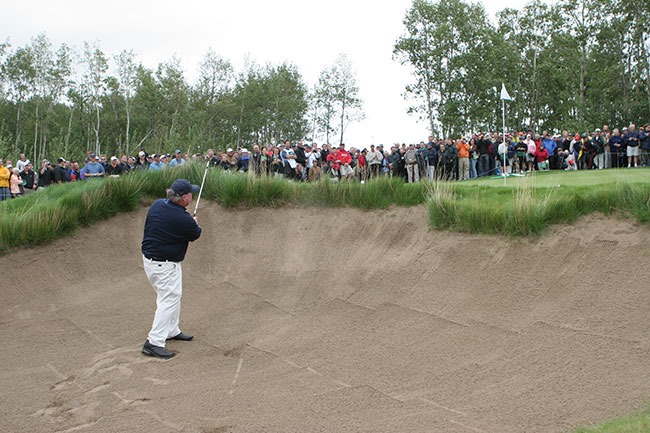
Features
Golf
Golf Course Readiness
Golf course design and its upkeep that keeps architect and superintendent on same page
Leaving a manageable product in super's hands
December 15, 2022 By Mike Jiggens
 Bunkers featuring rough fescue along their edges are becoming more popular and have been inspired by Scottish golf.
Photo: Turf & Rec
Bunkers featuring rough fescue along their edges are becoming more popular and have been inspired by Scottish golf.
Photo: Turf & Rec Golf course design and golf course management must be linked together to create a more sustainable product, one of Canada’s foremost architects says. Graham Cooke, founder of Quebec-based Northern Golf Design, notes the designer and superintendent must be on the same wavelength in terms of how a course is built, shaped, drained, watered, grassed and maintained.
“Course management will return a more desirable and manageable product,” Cooke said last winter while speaking at the virtually delivered Ontario Turfgrass Symposium. “When the architect has completed the course, those left with the responsibility of course management have a product that meets their expectations.”
When designing public golf courses, features that bring excitement are needed, Cooke added.
“You also want people to get around the course in a fairly decent amount of time.”
A public course he designed in New Brunswick features a pot bunker on one hole, but it’s one most golfers won’t find. However, it adds excitement, drama and creates a talking point, he said.
When he first began his design of Willow Valley Golf Course near Hamilton, Ont., the property was mainly flat at the outset. To add interest to the layout, he incorporated waste areas, ponds and lakes that helped set it apart from other neighbouring courses.
“When a golf course is too quiet, it doesn’t have the same memorability and doesn’t have the same drama.”
A golf course design should never begin until the architect understands the land, Cooke said. Before designing the Lakes Golf Course on Cape Breton Island, he said he walked the land about 10 times before feeling comfortable about the job. The property included streams, rocks and other natural features, and he considered it important the golf course fit into the property.
“Don’t start your design until you understand the land very well.”
Creating excitement
Many golf courses wish to be upgraded to create more excitement for golfers, and it’s a competitive edge several require these days, Cooke added.
Designers must be flexible, he said, and not stick with one set design. They must also be aware of the cost of golf course maintenance. He said his goal is to make golf courses playable and enjoyable and not worry about making them long enough “to challenge the (Bryson) DeChambeaus” of the world.
“You’re out there to sell. You need people playing these golf courses. You have to put some eye candy in. You’ve got to make sure it has good flow, and you’ve got to make sure it’s playable and maintainable.”
When the golf course is delivered by the architect and is put in the hands of the superintendent, it must allow him and his maintenance team not to be besieged by wear areas. Cooke said the architect must sometimes put his ego aside to allow the course to flow and be sustainable.
Inspired by Scotland
Much of his inspiration comes from Scottish golf. The Scottish bunker style, for example, is starting to catch on in North America. Cooke said he’s become a “fan” of fescue at the tops of bunkers, and it’s a feature that golfers are enjoying more today.
“We should all take a page out of Scotland,” he said, noting the Scottish want courses to play hard and fast and promote native grasses.
There is little front-end bunkering into Scottish greens, allowing golfers to hit approach shots with lesser clubs and watch the ball bounce onto the green.
“It’s a fun way to play golf. It takes a lot of good management.”
Incorporating front-end bunkers into a golf course design is the easiest way to make a course difficult, Cooke said.
“It immediately takes away all the opportunities for seniors, women and young people, unless you’re strong. The aerial game is lost. I don’t like golf courses that can only be played to a handicap by good players while everyone else struggles and can’t reach their handicap.”
Green speeds must also be kept in mind, Cooke said, noting that surfaces that register 12 or 13 on the Stimpmeter increase the amount of stress on the course. Faster greens are also detrimental to most golfers who are in the mid- to high-handicap range.
“It’s hard to read greens when they get really, really fast. It’s almost impossible to read them.”
Making compromises in the design of a golf course is often necessary, and such plans should be made in co-operation with the superintendent who will be taking over, Cooke said.
For example, greens designed to be more than 7,000 square feet in size or upwards of 9,000 square feet on each hole creates a challenge for the superintendent.
“I don’t think designers realize how much cost and stress that puts on a management program. I like a golf course that has small greens as well as some big greens, but they’re a reasonable size so they can be managed and keep costs in check.”
Asked how he would deal with a golf course that was looking to renovate in response to longer ball strikers, Cooke said if the land allows for it, a bunker or mounding in the fairway could be easily achieved.
“You can’t just say you’ll build a back tee. There isn’t the space there.”
Print this page